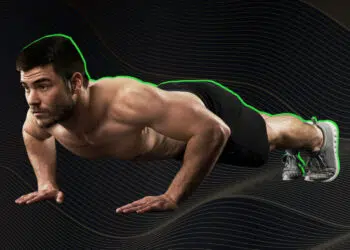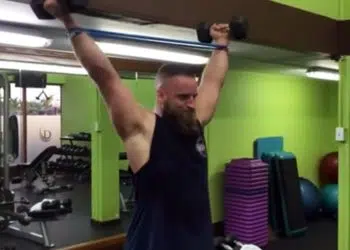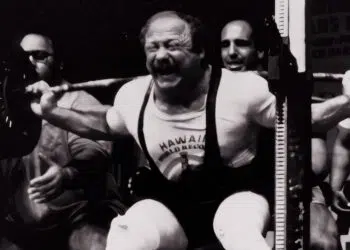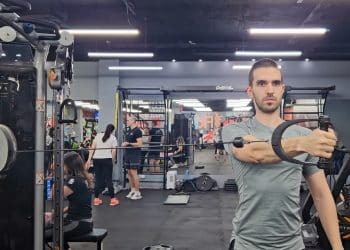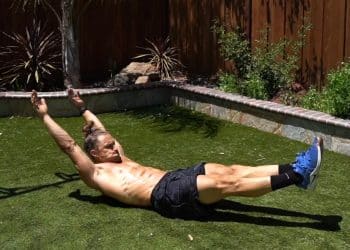Of all the injuries, aches, and pains that affect bodybuilders and weightlifters, shoulder problems are the most common. That’s because almost every exercise you do directly or indirectly involves your shoulders.
The shoulder itself is partly to blame, as it’s a very mobile joint prone to muscle imbalances. Combine that joint instability with a lot of wear and tear, and you have the perfect environment for joint pain.
A lot of exercisers choose to ignore mild shoulder pain and train through it. However, while that sometimes works, on other occasions, it makes things worse.
What started as an occasionally annoying ache can soon become so bad that it interferes with more than just your workouts. Chronic shoulder pain can make things like dressing, brushing your teeth, sleeping, and driving intolerably uncomfortable.
Of all the shoulder problems that can affect exercisers, shoulder tendonitis is the most likely.
In this article, we discuss the symptoms, causes, treatment, and prevention of shoulder tendonitis.
Level Up Your Fitness: Join our 💪 strong community in Fitness Volt Newsletter. Get daily inspiration, expert-backed workouts, nutrition tips, the latest in strength sports, and the support you need to reach your goals. Subscribe for free!
What is Shoulder Tendonitis?
Tendons are thick, inelastic cord-like structures that attach muscles to bones. Most tendons are known by the muscle to which they’re joined. For example, the quadriceps tendon is the tendon that connects your quads muscle to your tibia or shin bone.
That said, some tendons have their own unique name. One of the most well-known is the Achilles tendon, which attaches your calf muscle (the triceps surae comprising your gastrocnemius and soleus) to your calcaneus or heel bone.
Tendons are strong and inelastic, so they can efficiently transfer the force generated by your muscles to the joints they control. Unfortunately, tendons also have a poor blood supply which means that when they become injured, they usually take a long time to heal.
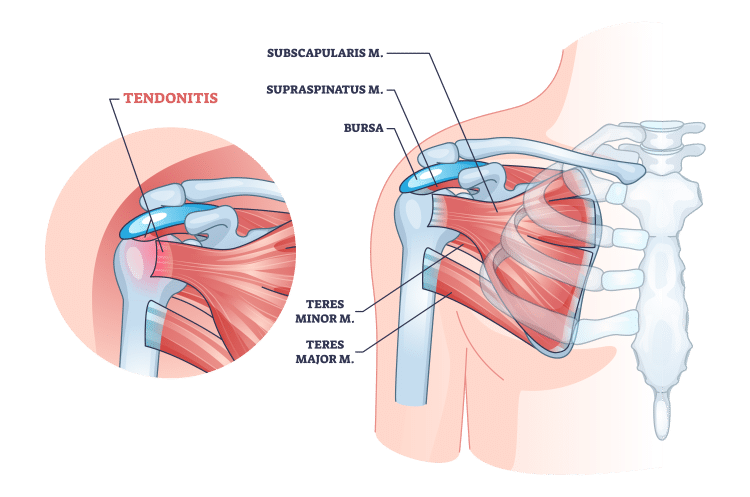
Shoulder tendonitis is the inflammation and swelling of the biceps or rotator cuff tendon. Tendonitis is also known as tendinopathy. When the rotator cuff tendon is inflamed, the condition is usually known as rotator cuff syndrome.
Other names for shoulder tendonitis include:
- Swimmer’s shoulder
- Tennis shoulder
- Pitcher’s shoulder
- Lifter’s shoulder
The most common symptoms of shoulder tendonitis are:
- Pain and swelling of the affected area
- Pain made worse by lifting your arm
- Joint stiffness
- Clicking/grating when raising your arm
- Pain when reaching behind your back
- Restricted mobility
- Loss of strength in the affected arm
- Pain that causes you to wake up
Pain can vary from mild to severe, depending on the severity of the inflammation.
Shoulder tendonitis is usually diagnosed using special movement tests, X-ray, MRI, and/or ultrasonography. However, in most instances, these procedures are used to confirm that your shoulder pain is not the result of something more serious, e.g., a labrum or SLAP tear.
In summary, shoulder tendonitis is the inflammation of the rotator cuff or biceps tendon.
Causes of Shoulder Tendonitis
Shoulder tendonitis can come on suddenly, but it’s more common for it to develop gradually. While shoulder tendonitis may have no specific cause, it’s often linked to doing the same movement repeatedly and especially raising your arms overhead.
Bodybuilders tend to develop shoulder tendonitis because of overhead presses, although the bench press is another potential cause. Even a lot of biceps training can cause shoulder tendonitis as the biceps tendon crosses the shoulder joint.
Shoulder tendonitis can also result from poor technique, such as lifting or throwing incorrectly.
Some people’s shoulder joints are more prone to tendonitis than others. For example, if the affected tendons pass through a small acromial arch, they are more prone to rubbing against bones, increasing the risk of inflammation.
Poor shoulder stability can also increase the risk of developing tendonitis.
For example, if your shoulders lift or roll forward, they put more pressure on the shoulder tendons. That’s why in many exercise description on Fitness Volt, you’ll see instructions to pull your shoulders down and back before beginning your lift. Setting your shoulders in this way helps to minimize the risk of shoulder tendonitis.
In summary, the most common cause of shoulder tendonitis is overuse. However, the risk of tendonitis increases if you fail to set your shoulders correctly or perform exercises with improper technique. In addition, because of skeletal variances, some people are more prone to shoulder tendonitis than others.
Treatment of Shoulder Tendonitis
In most cases, shoulder tendonitis is treated using the acronym PRICE, which is used with most soft tissue injuries. PRICE is designed to remove the cause of the inflammation so healing can occur.
P – protection. This means stopping the activities that aggravate your shoulders to protect them from further injury. For example, you may have to stop doing overhead presses or whatever other exercises cause pain.
R – rest. If cutting specific exercises from your workouts doesn’t ease your pain, it may be necessary to stop all upper-body training for healing to occur. After all, the shoulder joint is involved in almost every exercise you perform.
I – ice. Ice is a safe, natural anti-inflammatory and pain killer. Using ice reduces swelling and may promote faster healing. Treatment of shoulder tendonitis typically involves icing the affected area 3-5 times a day for 15-20 minutes.
C – compression. Compressing the shoulder joint is not always practical, as you can’t wrap it in a snug-fitting sleeve. However, there are specially designed shoulder supports that may help protect and support your shoulder. Compression is thought to minimize swelling.
E – elevation. Like compression, this step is not really practical with shoulder injuries as the affected joint is already above your heart. However, sitting rather than lying down may help reduce swelling.
In addition, and under medical advisement, you may also use non-steroidal anti-inflammatory drugs (NSAIDs) like ibuprofen and naproxen to reduce pain and swelling.
Depending on the severity of your shoulder tendonitis, your doctor may also recommend one or several of the following:
Physical therapy
Physical therapy usually involves stretching and mobility exercises to help ease pain and restore your range of motion. Once the pain diminishes, your PT may also prescribe exercises to rebuild lost strength, improve joint stability, and reduce the risk of developing tendonitis again.
Ultrasound therapy
Ultrasound therapy uses sound waves to vibrate muscle and tendon fibers and cells to increase circulation, speed up the removal of metabolic waste products, and accelerate the healing process. Physical therapists and doctors usually have ultrasound machines at their disposal.
Dry needling
This procedure involves making small holes in the tendon with a fine needle. The aim is to stimulate the factors involved in tendon healing. Treatments are usually guided by using ultrasound imaging to ensure the correct area is treated.
Steroid injections
If your shoulder tendonitis doesn’t respond to more conservative treatments, your doctor may recommend localized steroid injections (corticosteroids) into the affected area to reduce inflammation. Such injections provide rapid relief of tendon pain. Still, they can also cause weakening of the tendon, which is why they are used only if required.
Platelet-rich plasma injections
This treatment involves taking a quantity of your own blood and separating the platelets and healing factors. These are then injected into the inflamed tendon to reduce inflammation and irritation. While research is ongoing, platelet-rich plasma injections have shown promise for treating chronic tendon conditions. Ask your doctor for more information.
Surgery
Untreated shoulder tendonitis can deteriorate to such a degree that the tendon partially or completely tears. In this case, shoulder surgery may be the only viable solution.
Shoulder surgery is usually done using a minimally invasive procedure called an arthroscopy. This involves two or three small incisions through which your doctor can insert various instruments, including a camera.
In some cases, the surgery may also include removing bone from the acromial arch so there is more space for the tendons to pass through. This reduces the chances of repeat problems.
Surgery is usually followed by physical therapy to restore the shoulder to full function.
Exercises for Shoulder Tendonitis
The following exercises may help alleviate, prevent, or promote recovery from shoulder tendonitis. However, they’re not meant to replace the advice of a medical professional.
First, some stretches…
Level Up Your Fitness: Join our 💪 strong community in Fitness Volt Newsletter. Get daily inspiration, expert-backed workouts, nutrition tips, the latest in strength sports, and the support you need to reach your goals. Subscribe for free!
1. Across the chest shoulder stretch
This gentle exercise stretches the posterior shoulder capsule, which may provide some relief from tightness and pain. Do this exercise several times a day for best results. Take care not to force the movement, as doing so could cause more harm than good.
Steps:
- Sit or stand in good posture with your shoulders relaxed.
- Extend your right arm out in front of your body.
- Reach the left hand behind your right elbow and gently pull the right arm across your chest.
- Gradually lower your left arm to stretch different shoulder muscle fibers.
- Perform this stretch for 30-60 seconds and then swap sides.
Muscles targeted: Posterior deltoids, trapezius, rhomboids.
Benefits:
- Very gentle stretch that’s ideal for inflamed shoulders.
- This exercise can be done anywhere and anytime.
- A good shoulder cool-down exercise.
Tips:
- Do this stretch to break up long periods of sitting.
- Increase your range of motion as you feel your muscles relax.
- Spend more time in the positions that feel tightest.
2. Shoulder pendulum stretch
The pendulum stretch uses the weight of your arm to gently distract and stretch your shoulder joint. This may help relieve the pressure on your inflamed shoulder tendons. The pendulum stretch is also a great way to warm up before more demanding exercises, as it should also increase blood flow in the affected area.
Steps:
- Lean forward and rest one arm on a bench or chair for support. Your upper body should be just above parallel to the floor.
- Allow your other arm to hang down from your shoulder.
- Keeping your shoulder and arm relaxed, gently circle it clockwise and counterclockwise, and forward and back.
- Continue for 30-60 seconds, and then switch sides.
Muscles targeted: Posterior deltoids, trapezius, rhomboids.
Benefits:
- A gentle, pain-relieving exercise.
- Increased blood flow and synovial fluid production to the affected area.
- Good for improving shoulder joint mobility.
Tips:
- Gradually increase the range of motion as your shoulder starts to loosen up.
- You can also do this exercise holding a light dumbbell for extra joint distraction.
- Keep your neck and lower back in a neutral position for safety and comfort.
3. Shoulder external rotation stretch
Overly tight internal rotators can increase your risk of developing shoulder tendonitis. If the muscles on the fronts of your shoulders are tight, your shoulders and arms may roll inward, putting pressure on the biceps and rotator cuff tendons. This exercise opens your shoulders by rotating your arms outward.
Steps:
- Stand facing a vertical structure, such as a doorframe, squat rack, or railing.
- Bend your elbow to 90 degrees and place the palm of your hand against the frame.
- Turn your upper body away, rotating your arm outward so you feel a stretch across the front of your shoulder.
- Hold for 30-60 seconds, and then relax.
- Repeat on the other side for the same duration.
Muscles Targeted:
Rotator cuff, anterior deltoid, pectoralis minor.
Benefits:
- Targets the internal rotator muscles that are often tight.
- No equipment required.
- Ideal for breaking up long periods of sitting.
Tips:
- Never force this exercise – take it easy!
- Increase the depth of the stretch as your muscles relax.
- Do this exercise several times a day, especially after long periods of inactivity.
4. Doorway chest stretch
Tight, overdeveloped pecs can contribute to shoulder tendonitis. Tight pecs pull your shoulders forward, reducing the space between your acromion and shoulder tendons. The doorway chest stretch not only elongates your pecs but also involves an element of external shoulder rotation, making it a time-efficient twofer.
Steps:
- Stand in an open doorway. Bend your arms to 90 degrees and place your forearms on the vertical doorframes. Your elbows should be level with your shoulders.
- Push your chest forward to gently stretch your pecs and shoulders.
- Hold this position for 30-60 seconds, and then relax.
Muscles targeted: Pectoralis major, anterior deltoid, pectoralis minor, rotator cuff.
Benefits:
- Ideal for contract/relax stretches.
- A convenient, comfortable stretch.
- An excellent exercise for increasing shoulder mobility and chest flexibility.
Tips:
- You can also do this exercise in an open corner.
- Use a split stance for balance.
- Gently press your arms forward for 5-10 seconds, and then relax into a deeper stretch.
5. Sleeper stretch
The sleeper stretch passively elongates the entire posterior shoulder capsule. It also affects the external rotators, which may also be tight. This is a common physical therapy exercise used in rehabbing shoulder tendonitis and other shoulder injuries.
Steps:
- Lie on your side with the arm you want to stretch lowermost.
- Extend your bottom arm out in front of you so it’s perpendicular to your body. Bend the elbow to 90 degrees so your forearm is vertical.
- Grip your wrist with the other arm and gently push your forearm away from your head and down toward the floor.
- Hold for 30-60 seconds, and then relax.
- Switch sides and repeat.
Muscles Targeted:
Rotator cuff, posterior deltoid.
Benefits:
- A good stretch for the hard-to-reach external rotator muscles.
- A comfortable stretch – you can even do it in bed.
- Easy to progress and measure your improvements by noting the position of your forearm in relation to the floor.
Tips:
- Rest your head on a pillow to avoid neck strain.
- Do this exercise on a padded mat for comfort.
- Use as little force as possible to avoid damaging your shoulder.
Now your shoulder is stretched and mobile, it’s time to strengthen it with the following exercises:
6. Cable external rotation
Most exercisers have strong internal rotators but weak external rotators. This creates an imbalance within the shoulder that increases the risk of developing shoulder tendonitis. Because of this, most shoulder prehab and rehab routines include work for the external rotator muscles.
Steps:
- Attach a D-shaped handle to an adjustable pulley machine set to waist height.
- Stand sideways onto the machine.
- Grip the handle with your outermost hand and pull your upper arm into your side, elbow bent to 90 degrees.
- Keeping your forearm parallel to the floor, rotate your arm outward as far as comfortable.
- Return to the starting position and repeat.
- Turn around and do the same number of reps on the opposite side.
Muscles targeted: Rotator cuff, posterior deltoid.
Benefits:
- An effective exercise for strengthening the often-weak external rotators.
- An accessible exercise as most gyms have an adjustable cable machine.
- Easy to scale by adjusting the weights.
Tips:
- Use as large a range of motion as possible to improve mobility and strength simultaneously.
- You can also do this exercise with a resistance band – like this:
7. Band pull-aparts
Everyone who works out should do band pull-aparts. This accessible exercise strengthens your upper back and posterior deltoids while giving your chest and anterior delts a welcome stretch. Do 50-100 reps of this exercise every day using a light to medium-weight resistance band. Spread your sets out so you do some reps every couple of hours.
Steps:
- Stand in good posture with your shoulders down and relaxed. Look straight ahead.
- Hold a resistance band with an underhand, shoulder-width grip. Raise your arms in front of you so they’re parallel to the floor.
- Open your arms and stretch the band out across your chest to form a T-shape.
- Pause for 2-3 seconds.
- Return to the starting position and repeat.
Muscles targeted: Trapezius, rhomboids, posterior deltoids.
Benefits:
- This exercise is good for all aspects of shoulder health.
- An effective warm-up before upper body strength training.
- A beneficial posture and upper back exercise.
Tips:
- Use a narrower grip to make this exercise more demanding.
- Increase the thickness of the band as you get stronger.
- Do this exercise with an overhand grip if preferred.
8. Stability ball arm circles
Stability ball arm circles teach you how to set your shoulder blades while simultaneously strengthening your rotator cuff. This will help you keep your shoulders biomechanically sound as you develop stronger, more stable shoulders.
Steps:
- Hold a stability ball against a wall and use your elbow and forearm to keep it in place.
- Pull your shoulder down and back and set your scapulae.
- Move the ball in small clockwise and counterclockwise circles. Maintain constant pressure with your elbow and forearm.
- Do the same number of reps on both sides.
Muscles targeted: Pectoralis minor, rotator cuff, serratus anterior.
Benefits:
- Teaches you how to set your shoulders before lifting weights to protect them from injury.
- An excellent way to strengthen your serratus anterior and other often underused shoulder muscles.
- Ideal for home workouts as minimal equipment is needed.
Tips:
- You can also do this exercise with your arm straight and palm pressed against the ball.
- Use a light medicine ball instead of a stability ball if you wish.
- Perform small, medium, and large circles to affect different parts of your shoulders.
9. YTWs
YTWs are a bodyweight exercise that stretches the muscles on the front of your shoulders while strengthening those on the back. You don’t even need a bench to do this exercise, so it’s the perfect excuse-free prehab/rehab movement for shoulder tendonitis.
Steps:
- Lie on your front with your forehead resting on the floor. Place your arms in front of you, forming a Y-shape. Point your thumbs up toward the ceiling so your palms face inward. Pull your shoulders back and down.
- Without arching your lower back, lift your arms a few inches off the floor.
- Next, sweep your arms back to form a T-shape, keeping your thumbs pointing upward.
- Finally, bend your arms and pull your elbows down and into your sides, forming a W-shape. Squeeze your shoulder blades back and together.
- Return to the starting Y position and repeat.
Muscles Targeted:
Trapezius, rhomboids, deltoids, rotator cuff.
Benefits:
- Easy to learn, and no equipment is required.
- An excellent exercise for better posture and general shoulder health.
- An effective way to stretch and strengthen your shoulders at the same time.
Tips:
- Rest your head on a folded towel to keep your neck neutral, and place a folded mat under your hips for comfort.
- Lower your hands to the floor between reps if you need a rest, or keep them off the floor for a more intense workout.
- Make this exercise harder by holding weight plates or light dumbbells.
10. Resistance band chest opener
This exercise combines stretching with strengthening to ease shoulder tension and improve the condition of your rotator cuff muscles. Using a band is preferable to a yoga strap or towel as it allows you to vary the width of your hands according to your angle-dependent mobility.
Steps:
- Stand in good posture with your shoulders down and relaxed. Look straight ahead.
- Hold a resistance band with an overhand, wider-than-shoulder-width grip.
- Raise your arms forward, overhead, and then down behind you. Move your hands as far apart as necessary to perform this movement.
- Return to the starting position and repeat for the required number of reps.
Muscles Targeted:
Pectoralis major, pectoralis minor, deltoids, rotator cuff.
Benefits:
- An excellent shoulder warm-up and strengthening exercise combined.
- Develops shoulder stability and mobility simultaneously.
- Easy to scale by using a stronger band or moving your hands closer together.
Tips:
- Start with a light band and increase as you get stronger.
- Move your hands inward as your mobility improves.
- Do this exercise as part of your upper body warm-up.
Shoulder Tendonitis FAQs
Do you have a question about shoulder tendonitis or shoulder health in general? No worries because we’ve got the answers!
1. Why are shoulder injuries so common for strength trainers, weightlifters, and bodybuilders?
It’s true – shoulder injuries are common among folk who lift heavy weights. While the exact cause varies from person to person, contributing factors include
- High volumes of repetitive movements
- Doing lots of overhead exercises
- Too many pushing and too few pulling exercises
- Lifting too much weight too soon
- Poor training technique
- Advancing age
- Not respecting the body’s need for rest and recovery
- Not doing enough mobility and stretching
- Ignoring minor aches and pains and training through injuries
- Shoulder joint dysfunction/abnormalities
While some of these issues are unmodifiable and beyond your control, others are not. You can reduce your risk of shoulder injuries by, for example, following an anatomically balanced program, warming up properly, and lifting with good technique.
2. What exercises should I avoid to prevent shoulder tendonitis?
Almost any exercise can cause shoulder tendonitis if you do it too often or with poor technique. That said, some exercises are riskier than others and are best avoided or only done occasionally. This includes:
- Wide grip bench presses
- Wide grip parallel bar dips
- Behind-the-neck presses
- Behind-the-neck pull-ups and pulldowns
- Steep incline biceps curls
If you feel any exercise more in your shoulder joint than the muscles you’re trying to develop, it’s a good indicator that you should avoid it.
3. The front of my shoulders hurt after training. What should I do?
It’s beyond the scope of this article to give medical advice. After all, we’re not doctors. However, the general consensus is that you should rest and ice your shoulders to see if they get better on their own.
If they don’t feel better after a few days or get worse, your next stop should be a doctor specializing in treating athletic shoulder injuries. The worst thing you can do is train through pain, try to self-diagnose your injury, or treat it yourself with OTC anti-inflammatories or painkillers.
So, our advice is to get a hands-on assessment to see what the problem is and then follow the instructions of your chosen medical professional.
4. Can I continue training if I have shoulder tendonitis?
No one likes taking unplanned breaks from training, but it may be necessary if you have shoulder tendonitis. The shoulder joint is involved in virtually every upper-body exercise and many lower-body movements, too, so it’s a tough joint to rest.
That said, you may be able to do some exercises that are less shoulder-dominant, such as leg presses, leg extensions, leg curls, and biceps and triceps isolation exercises. You may also be able to do some isometric exercises for your upper body, as they tend to put less stress on your shoulder joints. Lower body cardio and many core exercises should also be okay.
So, you can probably work around shoulder tendonitis. Still, it’s best not to try and train through shoulder pain, as doing so will delay your recovery and could make matters worse.
5. What can happen if I ignore shoulder tendonitis?
While it can be tempting to train through shoulder tendonitis, doing so could have a significant impact on your long-term shoulder health. Complications from untreated shoulder tendonitis include:
- Increased risk of more serious shoulder injuries
- Full-thickness tendon tears that require surgery to repair
- Tendon calcification
- Arthritis
- Permanently reduced range of motion
- Constant pain
So, don’t be a dummy – get your shoulder pain assessed and treated so it doesn’t get worse and cause you even more problems, some of which could be permanent.
Shoulder Tendonitis – Wrapping Up
Your shoulders are amazing! They can perform a vast array of movements and incredible feats of strength. When well-developed, the deltoid or shoulder muscles are the capstones of your physique, giving your upper body its width and V-taper.
Shoulders rock!
But, the shoulder joint is also inherently unstable, making it prone to injury. Some of the muscles in the shoulders are also very small and weak, making them easy to injure.
So, look after your shoulders by avoiding exercises that compromise your biomechanics. Warm up properly, follow a balanced program, and don’t neglect your prehab.
Finally, if you are unlucky enough to experience shoulder pain, such as tendonitis, don’t ignore or try to self-treat it. Instead, get yourself to a doctor and get it checked out by a trained professional.
While this may involve a short-term break from working out, that’s always preferable to being forced to give up training because your shoulders are permanently damaged.
Interested in measuring your progress? Check out our strength standards for Bench Press, Pull Ups, Cable External Rotation, and more.



